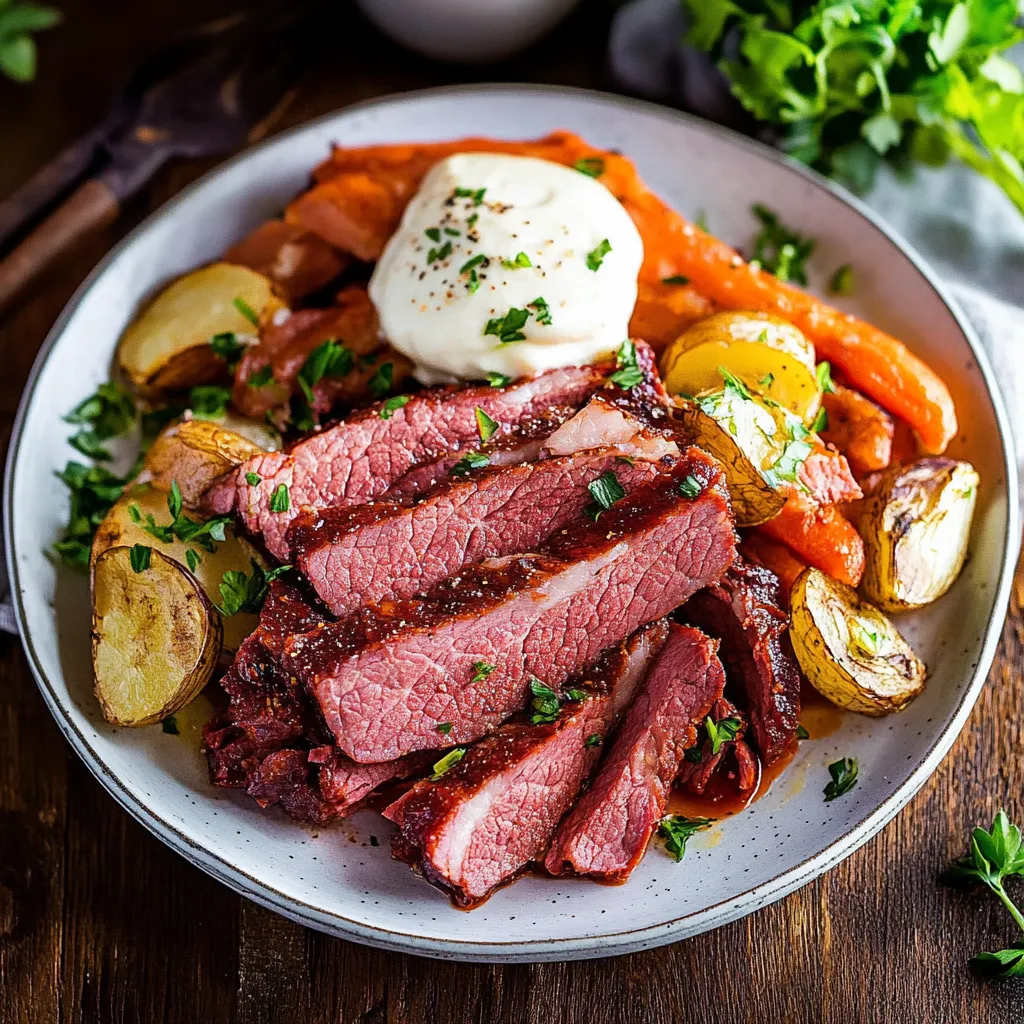 Pin it
Pin it
This hearty corned beef and cabbage recipe has been my seasonal staple for years. Using the slow cooker results in melt-in-your-mouth tender meat while infusing the vegetables with incredible flavor. Perfect for St. Patrick's Day or anytime you crave a comforting, complete meal that practically cooks itself.
I first made this during a snowy March weekend years ago, and it instantly became our family's St. Patrick's Day tradition. The smell of the spices and beef slow-cooking all day builds anticipation for one of our favorite meals of the year.
Ingredients
- Corned beef brisket with spice packet: Provides authentic flavor and comes pre-brined for your convenience
- Beef broth: Creates a flavorful cooking liquid that keeps the meat moist throughout the long cooking process
- Whole grain mustard: Adds tanginess that cuts through the richness of the beef
- Fresh garlic and onion: Build a savory foundation and infuse the cooking liquid
- Fresh thyme and bay leaves: Provide aromatic herbaceous notes
- Carrots: Add natural sweetness and beautiful color to the dish
- Cabbage sautéed in butter: Becomes incredibly flavorful after absorbing the cooking juices
- Red potatoes: Roasted separately to maintain their texture and develop crispy exteriors
Step-by-Step Instructions
- Sear the Beef:
- Heat your skillet until very hot before adding oil and the corned beef. A proper sear takes 2-4 minutes per side until golden brown. This crucial step creates the foundation of flavor for the entire dish through caramelization.
- Create the Cooking Liquid:
- Combine beef broth with whole grain mustard and deglaze the searing pan to capture all those flavorful browned bits. This step ensures no flavor is left behind and creates a more complex broth.
- Layer the Aromatics:
- Add smashed garlic cloves, onion wedges, peppercorns, thyme, and bay leaves to the slow cooker. These ingredients work together to create a fragrant broth that will infuse everything with flavor over the long cooking time.
- Slow Cook the Beef:
- Cook on low for 6-7 hours until the meat begins to become tender. The low temperature allows the tough connective tissue to break down slowly without overcooking the meat.
- Add Carrots and Continue Cooking:
- Layer quartered carrots on top of the partially cooked beef and continue cooking for 1-2 more hours. Adding them later prevents them from becoming mushy while still allowing them to absorb the flavorful broth.
- Prepare the Cabbage:
- Sauté cabbage wedges in melted butter until slightly wilted but still holding their shape. The butter adds richness while the brief cooking time preserves some texture before adding to the slow cooker.
- Finish the Dish:
- Add the sautéed cabbage on top and cook for a final 30-60 minutes. This timing allows the cabbage to soften while absorbing the flavors without disintegrating into the broth.
 Pin it
Pin it
This is one recipe where patience truly pays off. I discovered that the long, slow cooking process is what transforms an otherwise tough cut of meat into something spectacularly tender. The first time I rushed it, my family noticed immediately, and now I always plan for the full cooking time.
The Secret to Perfect Corned Beef
The magic happens when you resist the urge to rush cooking. Traditional corned beef comes from the brisket, a naturally tough cut that becomes wonderfully tender only through slow cooking. Searing before slow cooking creates a flavor foundation that develops throughout the long cooking process. The meat should be so tender that it pulls apart easily with a fork but still holds its shape when sliced against the grain.
Understanding Corned Beef Cuts
You'll typically find two cuts of corned beef at the grocery store: the flat cut and the point cut. The flat cut is leaner, more uniform in shape, and slices beautifully. The point cut has more marbling, is more flavorful, but can be a bit more difficult to slice neatly. Either works wonderfully in this recipe, though I personally prefer the flat cut for serving guests since it presents so nicely on a platter.
Serving Suggestions
For the full traditional experience, serve your corned beef and cabbage with homemade horseradish sauce and Irish soda bread. The horseradish cuts through the richness of the meat while the bread helps soak up the flavorful juices. Arrange everything on a large platter with the sliced meat in the center, surrounded by the vegetables for a stunning presentation. A cold Irish beer or hard cider makes an excellent beverage pairing.
Why Roast Potatoes Separately
Cooking potatoes in the slow cooker often results in waterlogged, mushy results. By roasting them separately in the oven, you achieve the perfect contrast of crispy exteriors and fluffy interiors. The potatoes can cook while the cabbage finishes in the slow cooker, and your timing works out perfectly. This small extra step elevates the entire meal from good to exceptional.
Frequently Asked Questions
- → How do you prepare the corned beef for cooking?
Sear the corned beef on both sides in a skillet with hot oil until golden brown. This locks in flavor before slow cooking.
- → What vegetables pair well with corned beef?
Cabbage, carrots, and roasted potatoes complement corned beef perfectly, absorbing its savory flavor without overpowering the dish.
- → Can you cook this dish without a crock pot?
Yes, use a Dutch oven to sear the meat and then roast it with broth and seasonings in the oven at 300°F until tender.
- → What is the best way to serve corned beef?
Slice the corned beef against the grain after resting. Serve on a platter with the carrots, cabbage, and roasted potatoes.
- → Is there a substitute for horseradish sauce?
For a milder option, try serving the dish with mustard or a light sour cream-based sauce instead of horseradish.
